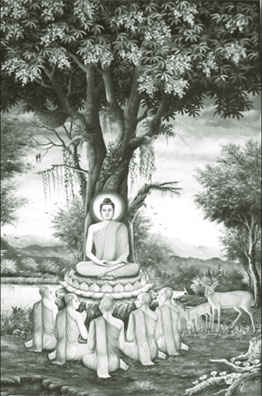|
Esala Full Moon Poya Day tomorrow:
The Buddha's first sermon at Isipathana
by Sumana Saparamadu
The Esala Full Moon Poya Day that dawns tomorrow is of special
significance to Buddhists the world over.
Esala is a special Full Moon Poya Day, for it was on this day, eight
weeks after the Enlightenment that the Buddha delivered His first sermon
to a group of ascetics in the Deer Park at Isipathana, Benares.
The theme of His sermon was avoiding the two extremes of sensual
pleasures and self denial. Esala also marks two other important
happenings in the life of the Buddha.
 The Great Renunciation also took place on a Esala Full Moon Poya Day.
On that day when he was 29 years old Prince Siddhartha left his wife and
new-born son and all the comforts and pleasures of life in the palace
for a life of an ascetic. The Great Renunciation also took place on a Esala Full Moon Poya Day.
On that day when he was 29 years old Prince Siddhartha left his wife and
new-born son and all the comforts and pleasures of life in the palace
for a life of an ascetic.
It was a day when all at Kapilavasthu was in a holiday mood. The
prince was out in the park and had enjoyed himself in the royal pool,
when a courtier brought the news that his consort Yasodhara had given
birth to a baby boy. His immediate reaction was ‘Bhandanam Jatam’ -
another fetter.
Turning point
That was the turning point in his life. That night when musicians
were playing and girls were singing and dancing in the palace, the
Prince secretly left the palace, giving up the lay life for good.It was
at the height of another Esala festival 30 years earlier that Queen
Mahamaya, King Suddhodhana's consort, had a strange dream.
After taking part in water sports she had retired early to bed. She
dreamt a white baby elephant entering her womb. Soothsayers interpreted
the dream as an omen that the Queen will give birth to a baby boy
destined to be a Maha Purusa – a hero. True to the forecast a baby boy
was born 10 months later and he was named Siddhartha.
The feasting and merry-making in the Gangetic plain, culminating on
the Esala Full Moon Day was the last fling before the on-set of the
monsoon. Then it poured for days on end. It was a continuous rain for
three months. Travel became impossible in those far off days. Hence the
Buddha advised Bhikkhus to stay in one place and not wander about until
the rainy season ended.
Retreat
This was the how the observance of Vas, the three-month retreat
began. Esala Full Moon Poya Day which marks the commencement of Vas, is
an important date in the Sangha calendar.
Esala was a carnival time in North India in the 5th century BC. Esala
was the last month of Summer Gimhanam pachchimo maso and the approach of
the rainy season Vassa Upanayika. It was like a carnival time in South
America and some European countries before Lent.
It was the last fling before the lashing rains forced people to stay
indoors.Climatic changes are different in Sri Lanka from south of the
Ganges plain, but the customs and rites of Esala were observed by our
kings and through generations are observed upto the present day.
Chulavamsa, the continuation of the Mahavamsa, mentions an Aashalha
Keela in the reign of Parakrama Bahu I (12th century).
Here the Pali word Keela means festival. Dr. Davy, physician to
Governor Brownrigg, who wrote a comprehensive account of Kandy's Esala
Mangalla says, ‘It properly is called Esala Keli'.
The Chulavamsa records that on a Full Moon Day of Esala, King Pundit
Parakramabahu of Dambadeniya inaugurated a festival in honour of God
Upulvan at Devinuwara. At that time (13th century) and upto the close of
the 15th century.
National god
Upulvan was the God whose blessings were most sought after. He was
like the national god of Lanka, until during the reign of Rajasinha I,
under Hindu influence Upulvan and Vishnu became one – both being blue in
complexion - and the Upulvan Shrine became the Vishnu Devale.Esala was
and still is the month of festivals in honour of gods – held in their
shrines – devales or kovils.
The Esala Mangallaya was one of the four festivals in the old capital
Mahanuwara (Kandy), in honour of the four gods. Natha, Vishnu,
Kataragama and Pattini whose shrines were around the king's place.
The Munnesvara Devale festival is in honour of God Ishvara,
Althnuwara (Kegalla district the festival is in honour of God Dedimunda
and Ratnapura Devala festival and that in Mahiyangana are in honour of
God Saman. There are many more – too many to mention by name.
In Jaffna there is the Nallur temple festival in honour of God
Skandha.
It is undoubtedly the grandest Esala festival in Sri Lanka, going on
for 25 days.
The culmination of these festivals is the procession on the last
night, three nights at Nallur – when the insignia of the God is taken
out in a procession for the public to see and venerate.
Esala has become the season of peraheras starting with the Kataragama
perahera, followed by the Devinuwara perahera. In the hill country – the
old Sinhala kingdom, the cycle of peraheras starts with the Aluthnuwara
perahera followed by Kandy's Esala or Dalada perahera.
Ratnapura's Saman Devala perahera comes after the Dalada perahera and
the cycle ends with the perahera at Mahiyangana.
In the low country numerous Esala peraheras were started in the past
century with no connection with devala festivals and they go on through
the months of Nikini and Binara (August-September) and end with the
Kotte perahera in the capital Jayewardenepura. |


